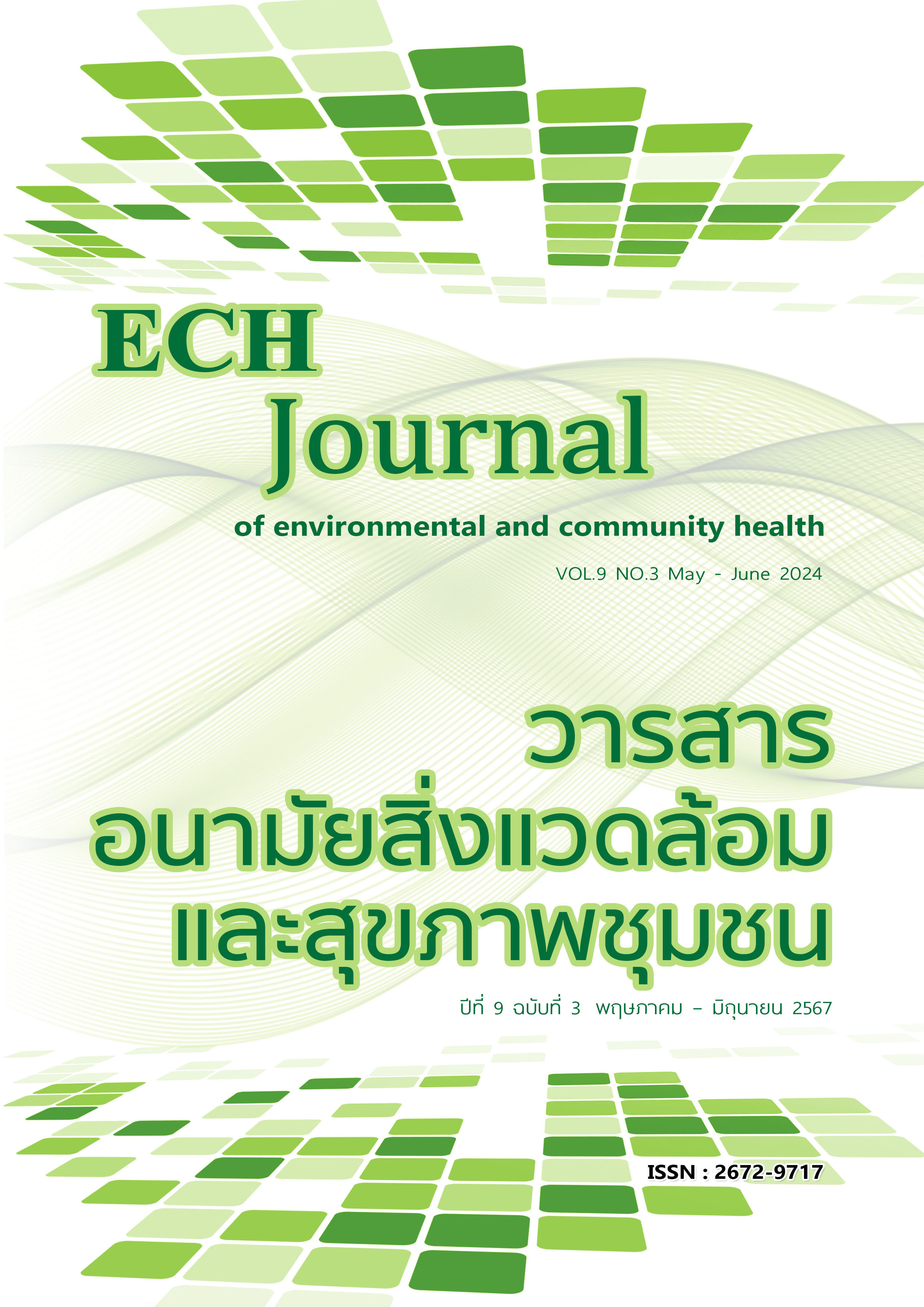ประสิทธิผลการใช้แนวปฏิบัติทางการพยาบาลเพื่อลดการบาดเจ็บบริเวณจมูกในทารกแรกเกิดที่ได้รับออกซิเจนแรงดันบวกอย่างต่อเนื่องในโรงพยาบาลศรีสงคราม จังหวัดนครพนม
คำสำคัญ:
การบาดเจ็บที่จมูก, ออกซิเจนแรงดันสูง, ทารกแรกเกิดบทคัดย่อ
การวิจัยกึ่งทดลองเพื่อศึกษาผลการใช้แนวปฏิบัติทางการพยาบาลเพื่อลดการบาดเจ็บบริเวณจมูกในทารกแรกเกิดที่ได้รับออกซิเจนแรงดันบวกอย่างต่อเนื่องในโรงพยาบาลศรีสงคราม สุ่มตัวอย่างทารกแรกเกิดที่ได้รับออกซิเจนความดันสูงทางจมูกเป็นกลุ่มทดลองและกลุ่มควบคุมกลุ่มละ 47 คน กลุ่มทดลองได้รับการปฏิบัติการพยาบาลโดยใช้แนวปฏิบัติที่พัฒนาขึ้น ดำเนินการวิจัยเดือนธันวาคม 2566-พฤษภาคม 2567 เปรียบเทียบระยะเวลาการเกิดการบาดเจ็บ สัดส่วนการบาดเจ็บและความพึงพอใจของพยาบาลผู้ใช้แนวปฏิบัติ เก็บข้อมูลโดยใช้แบบบันทึกการบาดเจ็บที่จมูกและแบบประเมินความพึงพอใจ วิเคราะห์ข้อมูลเป็นจำนวน ร้อยละ ค่าเฉลี่ยและส่วนเบี่ยงเบนมาตรฐาน เปรียบเทียบความแตกต่างระยะเวลาการบาดเจ็บที่จมูกด้วยสถิติ Independent t-test และทดสอบ Chi-square test และคำนวณค่าความเสี่ยงสัมพัทธ์พร้อมประมาณช่วงเชื่อมั่นร้อยละ 95 ที่ระดับนัยสำคัญ 0.05 ผลการวิจัยพบว่ากลุ่มตัวอย่างในกลุ่มทดลองและกลุ่มควบคุมเป็นเพศหญิงร้อยละ 42.5 และร้อยละ 51.1 อายุเฉลี่ย 9.6 วันและ 10.2 วัน น้ำหนักเฉลี่ย 2,871 กรัมและ 2,944.9 กรัม ความยาวเฉลี่ย 51.1 เซนติเมตรและ 51.3 เซนติเมตร การวินิจฉัยโรค Congenital pneumonia มากที่สุดร้อยละ 61.7 และ 66.6 ตามลำดับ มีระยะเวลาในการให้ออกซิเจนเฉลี่ย 10.5 วันและ 11.3 วัน ตรวจพบการบาดเจ็บที่จมูกในกลุ่มทดลองเฉลี่ย1.44 วันและเฉลี่ย 0.64 วัน ในกลุ่มทดลอง โดยกลุ่มทดลองมีระยะเวลาบาดเจ็บที่จมูกสูงกว่ากลุ่มควบคุมอย่างมีนัยสำคัญทางสถิติเฉลี่ย 0.79 วัน และมีความเสี่ยงบาดเจ็บที่จมูกน้อยกว่ากลุ่มควบคุม -3.54 เท่า โดยพยาบาลผู้ใช้แนวปฏิบัติมีความพึงพอใจภาพรวมมากว่าร้อยละ 80 โดยพึงพอใจต่อการนำไปใช้ประโยชน์มากที่สุด
เอกสารอ้างอิง
Jatana, K.R., Oplatekม A., Steinม M., Phillips, G., Kang, D.R., Elmaraghy, C.A.. Effects of nasal continuous positive airway pressure and canula use in the neonatal intensive care setting. Arch Otolaryngol Head Neck Surg. 2010;(136):287–91.
Diblasi, R. Nasal continuous positive airway pressure (CPAP) for the respiratory care of the newborn infant. Respir Care. 2009;54(9):1209–35.
Haymes, E. The effects of continuous positive airway pressure (CPAP) on nasal skin breakdown. J Neonatal Nurs. 2020;26(1):37–422.
Naha, N., Pournami, F., Prabraha, J. & Jain, N. Nasal Injury with Continuous Positive Airway Pressure: Need for “Privileging” Nursing Staff. Indian J Pediatr. 2019;86:595–8.
Chen, C.Y., Chou, A.K.., Chen, Y.L., Chou, H.C., Tsao, P.N. & Hsieh, W.S.. Quality improvement of nasal continuous positive pressure therapy in neonatal intensive care unit. Pediatr Neonatol. 2017;(58):299–35.
Yong, S.C., Chen, S.J., Boo, N.Y. Incidence of nasal trauma associated with nasal prong versus nasal mask during continuous positive airway pressure treatment in very low birthweight infants: a randomised control study. Arch Child Fetal Neonatal Ed. 2005;90(6):480–3.
Fischer, C., Bertelle, V., Hohlfeld, J., Forcada-Guex, M., Stadelmann-Diaw, C., Tolsa, J.F. Nasal trauma due to continuous positive airway pressure in neonates. Arch Dis Child Fetal Neonatal Ed. 2010;95(6):447–51.
Squires, A. J., & Hyndman, M. Prevention of nasal injuries secondary to NCPAP application in the ELBW infant. Neonatal Netw. 2009;28(1):13–27.
หอผู้ป่วยบำบัดวิกฤตทารกแรกเกิด โรงพยาบาลรามาธิบดี. สถิติการใช้เครื่องช่วยหายใจชนิดความดันบวกทางจมูกและอัตราการเกิดการบาดเจ็บของผิวหนังบริเวณจมูก ในทารกเกิดก่อนกำหนด ปี พ.ศ. 2552. กรุงเทพมหานคร: คณะ แพทยศาสตร์โรงพยาบาลรามาธิบดี; 2552.
Campbell, D. M., Shah, P. S., Shah, V., & Kelly, E. N. Nasal continuous positive airway pressure from high flow cannula versus infant flow for preterm infants. J Perinatol. 2006;(26):549–549.
Buettiker, V., Hug, M. I., Baenziger, O., Meyer, C., & Frey, B. Advantages and disadvantages of different nasal CPAP systems in newborns. Intensive Care Med. 2004;30:926–30.
Squires, A. J., & Hyndman, M. Prevention of nasal injuries secondary to NCPAP application in the ELBW infant. Neonatal Netw. 2009;28(1):13–27.
Jackson, J. K., Vellucci, J., Johnson, P., & Kilbride, H. W. Evidence-based approach to change in clinical practice: Introduction of expanded nasal continuous positive airway pressure use in an intensive care nursery. Pediatrics. 2003;111:e542–7.
Günlemez,A.,Isken,T.,Gökalp,A.S.,Türker,G.,& Arisoy, E.A. Effectofsilicongelsheetinginnasalinjury associated with nasal CPAP in preterm infants. Indian Pediatr. 2010;47:265–7.
Rego,M.A.C.,&Martinez,F.E. Comparisonoftwonasal prongsforapplicationofcontinuouspositiveairwaypressure inneonates. Pediatr Crit Care Med. 2002;3:239–43.
สุมลทิพย์ สนธิเมือง, เสริมศรี สันตติ, พิศสมัย อรทัย, และ, ทิพวัลย์ ดารามาศ. ประสิทธิภาพของการดูดน้ำมูก ในปากและจมูกโดยใช้เอ็มยู-ทิปในทารกเกิดก่อนกำหนดที่ได้รับการช่วยหายใจโดยใช้แรงดันบวกอย่างต่อเนื่องทาง จมูก. รามาธิบดีพยาบาลสาร. 2554;17(2):203–17.
ประชา นันท์นฤมิต. Continuous positive airway pressure (CPAP). In: สุนทร ฮ้อเผ่าพันธ์, พิมลรัตน์ ไทยธรรมยานนท์, และเกรียงศักดิ์ จีระแพทย์ (บก) Neonatology. ธนาเพรส; 2551. p. 107–14.
น้ำทิพย์ ทองสว่าง, เรณู พุกบุญมีและทิพวัลย์ ดารามาศ. การพัฒนาแนวปฏิบัติการพยาบาลเพื่อป้องกันการบาดเจ็บของผิวหนัง บริเวณจมูกในทารกเกิดก่อนกำหนดที่ได้รับการช่วยหายใจด้วยแรงดันบวก อย่างต่อเนื่องทางจมูก. Rama Nurs J. 2556;19(1):16–30.
ฝ่ายบริหาร โรงพยาบาลศรีสงคราม. ข้อมูลพื้นฐานโรงพยาบาลศรีสงคราม [Internet]. 2565. Available from: http://www.sskhospital.net/
หอผู้ป่วยเด็ก กลุ่มการพยาบาล. รายงานการเกิด Nasal injury ในแผนกทารกแรกเกิด ฝ่ายการพยาบาลโรงพยาบาลศรรสงคราม 2563-2565. นครพนม: เอกสารอัดสำเนา; 2565.
Chow, S-C., Shao, J., Wang, H., Lokhnygina, Y. Sample Size Calculations in Clinical Research. 3rd ed. New York: Chapman and Hall/CRC; 2017.
Schallom, M., Cracchiolo, L., Falker, A., Foster, J., & et al. Pressure Ulcer Incidence in Patients Wearing Nasal-Oral Versus Full-Face Noninvasive Ventilation Masks. Am J Crit Care. 2015;24(4):349–56.
Black, J., Mylene, B.M., Janet, C., Becker, D., Laura, E. & et al. National Pressure Ulcer Advisory Panel’s Updated Pressure Ulcer Staging System. Adv Skin Wound Care. 2007;20(5):269–74.
Rego, M.C. & Martinez, F.E. Comparison of two nasal prongs for application of continuous positive airway pressure in neonates. Pediatr Crit Care Med. 2002;3(3):239–43.





